The Veteran Of Fallujah Defeated By OH's Humidity
DÉJÀ VU ALL OVER AGAIN?
DEMOCRAT
HACKETT LOSES A SQUEAKER IN
OHIO’S 2nd CONGRESSIONAL
DISTRICT:
THE NEW VOTING RIGHTS STRUGGLE
2004-2005
by autorank
DemocraticUnderground.Com
2004
Elections Results and Discussion
Forum
ATLANTA, August 6 - Thousands of people marched down Martin Luther King Jr. Drive on Saturday to mark the 40th anniversary of the Voting Rights Act, in an event organized by the Rev. Jesse Jackson and attended by lawmakers and celebrities, including Stevie Wonder, Willie Nelson and Harry Belafonte.
New York Times, August 7, 2005

The Selma, Alabama Voting Rights March, 1965. Approaching the William J. Pettis Bridge.
The historic celebration of the Voting Rights Act occurred in a mood the Times described as “more cautionary than celebratory.” As they marched, participants knew that the Republican-dominated House and Senate were showing reluctance to fully renew the act.
The old and new voting right struggles merge.
Many marchers also knew that they are involved in a new voting rights struggle, one that involves blacks, whites, and any citizen voting for Democratic candidates. The struggle came into clear focus in Florida 2000 but in truth has been carried forth ever since the full implementation of the Voting Rights Act. While the act pushed forward the voting franchise to all Americans regardless of race, it was not able to ensure that all votes would be counted, particularly in predominantly black precincts, due to “spoilage” – ballots that are not marked clearly enough to be counted. A Washington Post study (12/3/04) after Florida 2000 showed that spoilage occurred at exceptionally high rates in precincts with greater than 70% black population. The total spoiled votes in just black precincts in Florida 2000 would have given Gore a comfortable victory margin without any reference to “hanging chads” and “butterfly ballots,” under the reasonable assumption that most of the discarded ballots were marked for Gore.
Florida 2000 also introduced a new level of state intervention to impede voting rights. The famous Florida “felon purge” effort was initiated by Governor Jeb Bush and his then Secretary of State and Florida Bush Presidential Campaign Chairman Katherine Harris. This purge, conducted with ChoicePoint software, resulted in the disenfranchisement of at least 50,000 black Floridians who were legitimately eligible to vote. This marked the beginning of the new voting rights struggle, combining the elements of bias by highly political secretaries of state, computer systems and software to handle registration and voting lists, and voting machines for casting and tabulating ballots. By 2006, 80% of the votes in the United States will be counted by just two firms, Diebold and ES&S, both with executives who endorse extreme right right-wing positions.
Ohio’s 2004 Presidential election represented the latest phase of the voting rights struggle, combining both racial discrimination and the new voting rights issue, the possibility of election fraud through the manipulation of voting and tabulation machines and software, as well as partisan access to communication systems for reporting tallies to central processors.
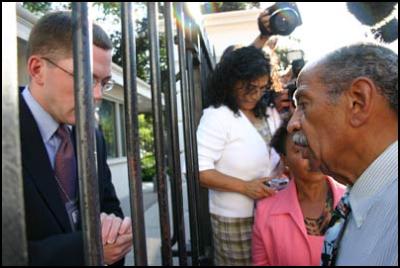
Rep. John Conyers, D, MI presents a petition to a White House aide.
The only official study of Ohio’s problems was conducted by John Conyers and House Judiciary Committee members shortly after the election. Conyers details his findings in What Went Wrong in Ohio: the Conyers Report on the 2004 Presidential Election. Tactics to ensure a Bush win in Ohio included race-based voter suppression targeting black citizens, misallocation of voting equipment, and strange happenings. One of the strangest irregularities was the lockout of observers and media by Warren County’s Board of Elections during vote counting due to a “national security alert” provided directly to their location. The FBI flatly denied that any such alert to Warren was issued.
Others have examined Ohio’s numerous problems, including Fitrakis and Wasserman; Richard Hayes, PhD; and numerous voting rights-election fraud activists. The election was challenged by Green and Libertarian Presidential candidates and several suits are still pending. The investigation of Ohio 2004, initiated just nine months ago, continues by a variety of election fraud volunteer activists in Ohio and electronic activists from around the country who congregate at DemocraticUnderground.Com’s 2004 Election Results and Discussion Forum, as well as BradBlog. Others, including Fitrakis and Wasserman, attorney Cliff Arnebeck are challenging the election in the court.
An unlikely focus for the new voting rights struggle in a “safe” district.

The 2005 Hackett-Schmidt contest for Ohio’s 2nd Congressional District took place in the midst of ongoing concerns about the 2004 Presidential election. Ohio was ground zero for Election Day irregularities, controversies, and charges of election fraud.
The Hackett-Schmidt contest began as an unlikely battleground for the new voting rights struggle. President Bush appointed Congressman Robert Portman as U. S. Trade Representative. Portman resigned from Congress on April 29, opening his seat for a special election. It seemed like an automatic Republican victory.
Southwestern Ohio, home of the 2nd district, is solid Republican territory, with a dream demographic for the party. Some 58% of its residents are married, 6% widowed, and only 12% divorced or separated. The district is overwhelmingly non-Hispanic white. Ninety-eight percent are U.S. citizens, with nearly an equal number described as non-Hispanic Caucasians. Ninety-six percent speak only English in their households. Only 1.3% list Spanish as the primary household language. The most common ancestries listed are predominantly German, Irish, and English, in that order. Over 60% describe their occupations as “management” (37%) and sales/office occupations (26%). The mean family income is near $50 thousand a year, the private sector workers outnumber government employees by a nine-to-one margin, and the poverty level is well below the national average, at 8%.
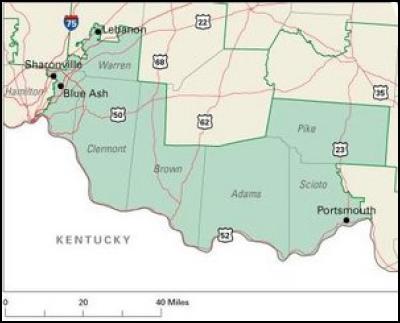
2nd Ohio Congressional District starts near suburban
Cincinnati and stretches east along the Kentucky border.
This is the district that had elected Republicans to Congress in all of the15 previous elections. Rep. Rob Portman won his most recent election with a 70% popular vote. The Democratic challenger, Charles Sanders, had tried four times to beat Portman and never once came close.
Something changed in the summer of 2004 in the 2nd district.
Hackett emerges as a threat.
The Democratic Party started out with little hope of winning, yet the race became competitive. Charles Sanders had never topped 28% in four tries against Portman. This election was different, with the Republicans absent the benefit of incumbency. As a veteran Cincinnati Enquirer reporter said prophetically on May 26, the Democrats saw “a faint crack of light through a door that may not open again for many years if they do not field the strongest possible candidate.” Hackett was viewed by both the leadership and party voters as that type of candidate. He had won a five-person primary with 56% of the vote in his first major political outing (he served on a town council previously).

Hackett is married with three young children, a successful lawyer, and a former active duty Marine. As a member of the Marine reserve, he volunteered to serve in Iraq and did so with distinction.

Hacket on duty. With Iraqi civilians.
He’s a graduate of an Ohio law school, has a concealed weapon carry permit, and uses his Harley Davidson to travel to political events. Well over six feet tall and in good shape, he has what they call “a commanding presence.”
The Republican circular firing squad and primary.
Hackett’s opponent, Jean Schmidt, is a long-time Republican officeholder. She was a member of the Ohio Assembly from 2000 to 2004 and elected in that year to the State Senate. She was seen as a supporter of the amazingly unpopular Governor Taft (17% approval rating) and a loyal Republican. Married and a native of the area, she has held an impressive array of public service positions over the years. One of these positions is the President of the Cincinnati Right to Life Corporations.
Schmidt emerged from a Republican primary that could best be described as a circular firing squad. This seat is viewed as lifetime political employment for Republicans. Ohio’s 2nd is rated one of the most Republican districts in the country. Fifteen consecutive victories and 70% of the votes in the last four elections make this nomination exceptionally attractive. Howard Wilkinson of the Enquirer summarized the primary just before the vote: “The race for the 2nd Congressional District started out as a collegial, friendly affair. Now it’s the check-bouncer versus the tax raiser versus the guy who ditched his wife.” Schmidt, “the tax raiser,” prevailed with 31% of the votes, followed by Bob McEwen, “the check bouncer” with 26%, and Pat DeWine, son of Ohio U.S. Senator Mike DeWine and “the guy who ditched his wife,” with 20% (after spending $1.0 million on the primary).
Hackett runs a strong campaign.
Hackett had three major advantages that many Democratic candidates lack. He had just finished an active duty tour in the military, he aggressively engages in intense political combat without flinching, and he has a concealed weapons carry permit. In addition to that, he opposes the war in Iraq with firsthand knowledge, is strong on national security, and has harsh comments for his Republican opponents. In a Cincinnati Post statement, Hackett said of Schmidt, “If you think America needs another career politician steeped in a culture of corruption who does as she’s told and toes the line on failed policies, then I’m not your candidate.” He referred to Schmidt as a “rubber stamp” Republican. He called Republican supporters of the war “chicken hawks” and he was harshly critical of President Bush. Just before the election, Hackett said of Bush, “I don’t like the son of a bitch who lives in the White House but I’ll put my life on the line for him.”
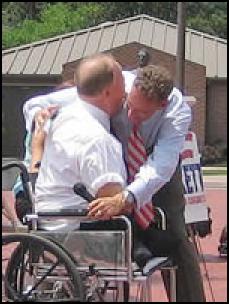
Hackett greets fellow vet former Sen. Max Cleland, D, GA.
Cleland was injured in Viet Nam. Cleland lost a questionable
Senate election in Georgia in 2002.
Hackett raised significant funds locally and from Internet activist Democrats, and had some support from the national Democratic Party. Schmidt received an infusion of over $500 thousand during the last few days of the campaign, which allowed her a significant media advantage just before Election Day. The candidates had two formal debates and several joint appearances on local television. Hackett gave strong performances during the debates and appearances and was described by some as charismatic.
Election Day.
Election Day was a tense event for both candidates and their supporters. Turnout reached 25%, considered respectable for a special election. There were some changes in voting locations in Clermont County and a reduction in precincts in Hamilton County, a populous Cincinnati suburb. There were few if any major incidents reported by those attempting to vote. There were reports of Jean Schmidt campaigning within the 100-foot perimeter candidates must recognize around the precincts. Until mid evening, this encroachment charge was the only event to remotely qualify as an election irregularity.
The humidity crisis.
Then it happened: the “humidity” crisis. For pure drama, it could not have occurred at a more dramatic point in the vote tabulation. Of Clermont County’s 191 precincts, 100 had been counted. Then the Board of Elections announced that excessive humidity had caused ballots to swell, making them difficult to count. As a result, there would be a delay in the count. At this point, the election was dead even statistically, at 50% for each candidate. The 91 precincts in Clermont represented about 12% of the remaining vote. When the crisis was resolved, the 50-50% tie changed into a 52% to 48% victory for Schmidt.
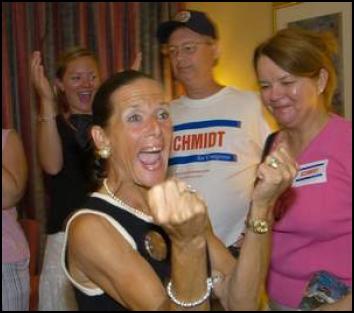
Schmidt celebrates her victory election night.
In the period between the Voting Rights Act of 1965 and the 2000 Presidential election, this series of events would have attracted little attention. The “spoilage” issue was there every four years, but the problem was largely ignored. But starting with 2000 and continuing through the 2004 election, it became obvious that black Americans were no longer alone in losing their right to vote and have it counted. What better place to demonstrate this than Clermont County and the Ohio 2nd Congressional District, with its negligible black population in the both populous and rural regions.
Unanswered questions about the humidity crisis.
While the humidity crisis delayed vote counting at a key time, local media barely covered the event. Board of Election officials stated that ballots had acquired sufficient humidity in 91 out of 191 precincts to require a delay in the vote count. They pointed out that their optical scan tabulator was slowed by the humidity of the ballots. Few details were offered on that process. The Cincinnati Post and all the major television outlets, save one, the Enquirer, were silent on the issue. Ironically, the only coverage of the humidity issue on besides the Enquirer and a local television station was in National Review Online, the traditional conservative magazine’s online service which mentioned the humidity.
The NBC affiliate, Channel 5, said, “The drama of a close race lasted late into the night. Schmidt led by less than one percent with 88 % of the precincts in. But she must have felt secure in knowing that the only uncounted precincts were in Clermont County, her home.” (Updated 1:13 pm EDT, August 3, 2005). We hear about “the drama of a close race” lasting into the night, but nothing about what caused the drama. The cause was the ballots taking on humidity. MSNBC, fed by the Cincinnati affiliate, treated the climax of the race like a sporting event: “With the home-field advantage, Schmidt dominated 58 % to 42 % in Clermont (16,162 votes to 11,689) and Warren counties (7,556 votes to 5,420).” There was mention of the sudden stoppage of vote tabulation when the race was at 50-50% at 10:40 pm.
Only Howard Wilkinson of the Enquirer implied questions. He began his August 2, 2005, analysis by saying, “The apparent win by Republican Jean Schmidt in Tuesday’s 2nd Congressional District election was in no way shocking, but the fact that Democrat Paul Hackett made it a very close election is nothing short of astounding.” Given the announcement of the final count by the time this was written, the use of “apparent win” might lead some to think Mr. Wilkinson has paid attention to the history of the 2004 Presidential election in Southwestern Ohio.
Wilkinson followed up on August 4, 2005, with an article headlined “ Clermont: Humid heat hurt count, not plotting.” He opened with, “Humidity held an edge over conspiracy in explaining a glitch in counting Tuesday night’s 2nd Congressional District returns in Clermont County.” He reported questions that had been raised on political blogs. He also spoke to Clermont Board of Elections official and Democrat Kathy Jones, who said that the humidity “simply slowed the process of running the ballots through the readers.” Senior Ohio Democratic official Michael Culp was quoted as saying, “It was apparently just a matter of paper ballots getting damp in the humidity.” The door was left slightly ajar when he reminded readers that Schmidt’s primary victory in Clermont County of 705 votes had multiplied overnight by 380% to a “corrected” 2,667 vote Clermont margin.
The Board of Elections explained the problem to the Associated Press on election night: “Tim Rudd says the ballots pick up moisture when it gets hot, making it tougher for the optical scan machines to sort and count.”
Questions not asked about the vote count stoppage.
The sudden stoppage of vote tabulation in Clermont was reminiscent of nearby Warren County’s Board of Elections citizen-media lockout during vote counting in 2004, which county officials claimed to be the result of a Homeland Security alert. There was no alert.
Was humidity the reason the optical scanning machine count stopped in Clermont, or was there some “intelligent design?” Humidity can impact the ability of optical scan counting machines to process paper ballots. It is not frequently reported and there are clear instructions providing easy remedies (e.g. air condition polling and tabulation facilities). The state of Louisiana made its 2003 RFP for voting machines contingent on tolerating a 98% humidity rate, for example. Air conditioning is reported to be widely available in Clermont County, as are dehumidifiers.
Why were 91 precincts impacted while 100 others were not in the same County?
Information about the locations of the humidity-impacted districts is unavailable. Was each of the 91 precincts without air conditioning? That would be a 48% rate of precincts exposed to conditions that the Board had to know could create problems. For them to announce problems with ballots due to humidity after the fact is remarkable. Certainly, they knew that humidity could be an issue. Just days before the special election there were extensive reports of a serious heat and humidity wave in the Cincinnati area. The regions largest newspaper, The Cincinnati Enquirer had been talking about the heat and humidity days before the election. Surely humidity on Election Day should have been taken into account.
Was there a one-to-one match between precincts with “humidified” ballots and precincts without air conditioning?
If so, why were nearly half of the precincts exposed to humidification? And if this is not so, if some of the 91 precincts with ballot problems due to humidity had air conditioning and some did not, how does the Board explain humidity problems in precincts with air conditioning?
Was Clermont the only part of the 2nd District that was affected by humidity that day and if so, why?
Clermont used optical scan paper ballots. Five other counties used punch card paper ballots, which have a similar or greater vulnerability to expansion or distortion due to humidity. There were no reports of problems in those five counties related to humidity. What is the critical variable that makes Clermont ballots vulnerable to distortion due to excessive moisture? Were precincts all air conditioned in the five counties that used punch card paper ballots? Was there something like an intense thermal inversion going on above the 91 precincts in Clermont County?
Why did the Board of Elections allow precincts to operate that lacked sufficient air conditioning to prevent humidity?
These questions need to be answered given the prior questions raised and documented about Clermont. The Board of Elections operates all year round. There is sufficient time to study manuals, attend vendor-sponsored retreats, and talk to nearby officials. Nearly half of the Clermont precincts had humidified ballots. A failure rate of nearly 50% is totally unacceptable performance for an election and offers the most unflattering commentary on those who are supposed to run it efficiently.
Precincts with the most votes favored Schmidt at nearly 100%, with Hackett winning in only those with less than 200 votes counted.
A review of precinct level results by TruthIsAll on DemocraticUnderground reveals this interesting trend. This data is preliminary and more detail needs to be obtained from the Clermont Board of Elections. However, the trend observed for Clermont makes little sense on the face of it.
Hackett won 38 of 191 Clermont precincts with fewer than 187 votes, but lost ALL of the largest 54 precincts (those with more than 187 votes each). This is reflected in the following graph produced by DemocraticUnderground poster TruthIsAll on of the first election fraud analysts to notice anomalies in Clermont County.
Graph: Hackett won 38 of 191 Clermont precincts but lost ALL of the 54 largest
The following percentages help elaborate the graph above.
Hackett’s percentage by precinct group size:
46.9% in precincts under 100 votes
43.5% in
precincts of 100-200 votes
39.6% in precincts of
200-300 votes
34.6% in precincts of 300 +
votes
These results raise interesting questions. Why does Hackett do much better in the smaller precincts? Are they more rural than the larger precincts? If so, does this not present a counterintuitive pattern, with the Democrat taking some of the conservative, less populated areas and the Republican winning all of the precincts in the most populated areas?
A question can be raised about the difference between turnout (the votes cast) and the actual size of the precinct, which may or may not be a reflection of votes cast.
The following graph, also produced by TruthIsAll, answers the question. As he said while commenting on this data on 8/5/05: “The regression line has zero slope. Voters turned out at a fairly constant rate across precincts. So turnout wasn't a factor in explaining why the Schmidt vote percentage increased as precinct size increased.”
Graph: No Correlation between Precinct Registration and Voter Turnout
Voter turnout in the larger precincts in Clermont County matches that in the overall 2nd District.
Hackett sweeps rural, lower-income areas, while Schmidt takes those wealthier, more populous.
On the face of it, this is odd. The demographical blue-red maps for the 2004 election showed a positive correlation between population density and Democratic (Kerry) votes. Yet in the 2nd District of Ohio in 2005, the exact opposite was true. Hackett dominated the least populated areas of the district, while Schmidt prevailed in the more populated areas. One observer said that Hackett performed as strongly as he did in rural District 2 because his handgun carry permit was publicized. This ignores the fact that the National Rifle Association endorsed Schmidt; it also ignores the generally prevailing positive attitude towards gun ownership in Southwest Ohio. This argument has one major problem. The NRA has one of the most disciplined political operations in the country. The members are consistent in following endorsements. The endorsement of Schmidt by NRA did not mean “think about voting for Schmidt” it meant “vote Schmidt.” Opposition from the NRA is a major impediment in rural areas.
The following chart shows the seemingly odd disparity between Hackett and Schmidt based on population density.
| | Hackett | Schmidt | Per Square Mile | | | | Median Family Income | ||
| County | Votes | % | Votes | % | White | Black | Other | ||
| | 2101 | 52 | 1911 | 48 | 47 | 97.3 | 0.2 | 2.50 | $29,315.00 |
| Pike | 2659 | 63 | 1559 | 37 | 63 | 96.3 | 0.9 | 2.80 | $31,649.00 |
| Brown | 3950 | 56 | 3100 | 44 | 86 | 97.8 | 0.9 | 1.30 | $38,303.00 |
| | 4925 | 63 | 2338 | 35 | 129 | 94.5 | 2.7 | 2.80 | $28,008.00 |
| Clermont | 12,439 | 42 | 17,320 | 58 | 394 | 96.6 | 0.9 | 2.50 | $49,386.00 |
| | 5420 | 42 | 7556 | 58 | 400 | 94.1 | 2.7 | 3.20 | $57,952.00 |
| | 23,597 | 49 | 25,011 | 51 | 407 | 72.4 | 24.5 | 3.10 | $40,964.00 |
Note that there is a sharp distinction between Hackett’s winning counties, which are all low population density and rural, and Schmidt’s winning counties, which are more dense and typically suburban. The difference in voters’ choices also shows up for income level. In Hackett’s four winning counties, median family income averages $31,818; in Schmidt’s counties, it averages $49,434. Median family income and population per square mile correlate positively, with each distinguishing Hackett from Schmidt counties.
There is another distinction between Hackett and Schmidt counties. Clermont and Warren Counties, both carried by Schmidt 58% to 42%, were involved in highly contentious 2004 election controversies. The Warren security alert was either a lie on the part of their Board of Elections or a collective delusion. The FBI flatly denies any alert. Clermont County did not distinguish itself during the recount, displaying inconsistent practices, secrecy, and general rudeness to the recount teams. In addition, both Warren and Clermont showed highly questionable registration patterns for the 2004 election. The Hackett counties were not mired in any major controversy during the 2004 election or recount.
Recent history, just nine months ago, explains the context of the Hackett “loss.”
Even the majority of commentators who have ignored the humidity crisis must admit that this part of the state has a recent history that raises red flags about fair elections. In 2004, Southwestern Ohio provided Bush with a significant victory, one that nearly matched his victory margin for the state.
When the challenges to the 2004 election began, the first to notice something unusual about the registration, voting, and results was statistician Richard Hayes, PhD. He looked at carefully at Clermont County. In “Election results in Southwestern Ohio,” in The Free Press (12/21/2004), Hayes observes: “…compared to 2000, the population increased by 3.12%, the number of registered voters increased by 10.06%, voter turnout increased by 18.18%, Bush’s point spread increased from 29.40% to 32.52%, and Bush’s victory margin increased from 40,197 votes to 52,550 votes.” This was accomplished by extraordinary registration and Bush victory margins in several major Clermont precincts. Hayes called the voter registration figures and the results “unbelievable.” Despite the increase in registration figures and turnout, “There are 23 precincts in Clermont County where turnout was up, but Kerry got fewer votes than Gore.”
The Clermont problems were just part of a larger set of strange occurrences in Southwestern Ohio in 2004. During vote counting at the Board of Elections, Warren County officials (Republicans and Democrats) told observers and media to leave the area. They announced later that this was necessary as a result of a Federal Homeland Security notice that Warren was subject to a terrorist threat. Feeling the extra people might get in the way of their response to the threat, officials asked them to leave. By the end of the night, there was no terrorist attack. There was, however, a substantial increase in Bush’s victory margin, from 29,176 in 2000 to 41,125 in 2004. FBI officials flatly denied issuing any special warning or terror alert to Warren County Board of Election officials.

Board of Election officials claimed that this other wise serene Warren County court house was the subject of a "national security alert" on election day. They evacuated media and observers from the vote tabulation area. The FBI categorically denied that any security alert ever took place.
In addition to these troubling events and odds-defying statistical results, there were problems during the 2004 Ohio recount in the month following the election.
Disturbing first-hand accounts from the Clermont County recount of the 2004 Presidential election
Election history and statistics are powerful investigative tools and can point those interested in a number of productive directions. However, personal accounts of the Clermont County goings-on provide a more immanent and troubling version of what went on in 2004. The Green and Libertarian Parties called for a recount of Ohio Presidential ballots. The Secretary of State issued guidelines for this. The recount was to be of 3% of the ballots cast. Although it was not specifically mentioned, the obvious intent was to generate a random sample of the precincts, consisting of 3% of the precincts’ vote total. Arrangements were made for observers who were either neutral or from the requesting parties.
In Clermont, irregularities and hostilities were the order of the day, according to three eye witnesses who gave affidavits to the Conyers committee. Stephen Spraley, an electrician and Ohio Democratic Party recount volunteer, offered a report of major significance. He saw a number of ballots with oval white stickers placed next to the candidate’s name and covering the Presidential selection. Spraley approached Assistant Board Director Kathy Jones, a Democrat, with a ballot on which a Kerry choice was covered with a sticker. Before Jones could speak, Dan Bare, the board chairman, said this would be addressed later at a board meeting. At the meeting, the board agreed that the stickers were part of a process in Ohio to avoid spoilage.
Spraley called Carolyn Betts, who was working as a recount observer in Hamilton County. Betts has both MBA and JD degrees, as well as impressive experience with white collar crime, fraud cases, and contentious financial transactions. Betts confirmed Spraley’s observations and concerns about altered ballots found during the recount. This observation carries added weight because it is contemporaneous and consistent with Spraley’s. Betts noted that Danny Bare said that using white sticker on candidate selections was an acceptable means of fixing ballot problems prior to vote counting. Bare restated and confirmed this position at the Clermont Board’s certification meeting for the recount. Betts also noted that Spraley told her he had asked to take a photograph of one of the altered ballots and was denied this request.
Witness Jeannine Tater came to Ohio as a Kerry observer of the recount. She has an MBA and is a teacher in her home state. She confirmed seeing ballots modified with oval stickers and also recounted a Board member denying that this ever took place, despite public acceptance of the claim at the Board certification meeting that followed the recount. Tater detailed a story highly relevant to the recent election. While observing ballot tabulation, she noted a disproportionately large stack of ballots from Union Township. She asked Kathy Jones about this. Tater was told that the ballot pile was twice the size expected due to a special referendum in Union Township requiring a two-page ballot. Jones asserted that there were 1190 ballots for Union, with 678 page ones, containing the Presidential selections, and 512 page twos for the referendum. When reviewing the results for Union, Tater noted that the Presidential vote tally was 1190 votes—878 for Bush and 378 for Kerry. According to this account, Jones – the Democrat on the Board, who is supposed to offer balance – had a completely incorrect understanding of the total votes cast for President in the precinct she was supposed to be recounting. Kathy Jones is the “Democrat” cited in the Enquirer who offered reassuring words that the “humidity” crisis was nothing out of the ordinary.
Witness Carolyn Betts attended the Clermont Board of Elections meeting on December 16, 2004, when the recount was certified. As she describes it, then and current Board Director Dan Bare was intent on certifying the recount by the December 20. He was also intent on accommodating his staff members’ desire for a holiday vacation. According to Betts’ account, Bare “would not discuss providing ballot books, uncounted absentee ballots and uncounted provisional ballots until the hand recount was complete.” “Ballot books” are the large bound printouts that poll workers use to check off names as voters enter the polling place. If there are 1000 votes cast in a precinct and only 800 signatures in the ballot book, there are serious problems. If any of the names on the ballot book cannot be confirmed as residents of the precinct, there are serious problems. For these reasons, ballot books are vital in determining the legitimacy of an election.
Along with other recount volunteers, Betts attended the Clermont Board meeting where the recount was certified. She noted that Bare explained the use of stickers to modify ballots. There was no challenge to these modified ballots being counted, even though the votes on them could not be observed. She also noted that the voter-signed ballot books were never provided to the recount team, nor were the uncounted and rejected absentee and provisional ballots, despite numerous requests. Unsigned ballot books were made available, but these are meaningless, since the recount team would need to see a signature next to a registered voter’s name to know that the voter actually showed up and voted. The board said that the recount team request for the Ohio recount did not mention “signed” ballot books; hence signed ballot books were not provided. This eliminated the ability of recount observers to verify that the number of votes cast was consistent with the number of voters who actually signed in and voted.
In addition, the Clermont recount was not done as a random sample. The 3% of votes recounted came from smaller precincts, because the Clermont board, according to Betts, believed this would create “fewer problems.” Even if none of the problems described had occurred, the use of a non random sample for a 3% recount meant that the recount was inherently flawed and invalid.
Is there enough evidence to doubt the results of the Ohio 2nd Congressional district election?
Yes, just the preliminary data and evidence raise some significant questions.
The process of questioning elections in the United States is a difficult one, because debate is often choked off in the corporate media. The numerous problems in Ohio raised by the Conyers Committee were ignored by corporate media. The detailed examination and exposition of security and other problems with voting machines, tabulators, and networking has been ongoing since at least Florida 2000. It receives little if any corporate media attention. The process of voter suppression through multiple methods was and is still ignored.

Both Secretary of State in Florida, in charge of elections
and Bush for President Campaign Chair, Harris and
Gov. Bush generated controversy with their “felon” purge.
Florida 2000 saw the deliberate purging of 50,000 voters from the rolls with a software program that the vendor warned would do just this. The state proceeded anyway and the expected result occurred. It cost Al Gore the presidency. Despite the fact that this occurred and is well known, the argument that the 2000 election was literally stolen is not mentioned in “polite company.” When the State of Florida settled the suit by the NAACP on voting rights problems in Florida 2000, they agreed in essence that Florida had kept legitimate voters from exercising their most basic right as a citizen. There was barely a whimper from the press. This is just Florida 2000.
In the case of the 2nd Congressional District in Ohio, the history is even more detailed. Ohio was targeted for Republican “optimization” well before the election. Secretary of State J. Kenneth Blackwell’s actions were consistent up to, on, and after Election Day. The overall Ohio record will not be reviewed here, but it voluminous and detailed, supported by strong evidence. For those interested, see work by Bob Fitrakis and Harvey Wasserman.
The record of Clermont and Warren Counties during the 2004 election has also been examined at length. It is a very sorry record. The delusional or deliberate lockout of observers and the media in Warren County is a disgrace. There were no consequences for this action despite the outrageous nature of the behavior by the Warren County Board (which supposedly was “balanced,” with an equal number of Republican and Democratic members). The extraordinary increases in registration that defied statistical logic in Clermont and other parts of District 2 are cause for concern, particularly since Bush’s victory margin in Ohio nearly matched his victory margin in Southwestern Ohio. The eyewitness descriptions of the Clermont Board’s lack of cooperation and inconsistent standards displayed during the recount are very troubling.
Clermont and Warren County election history of just nine months ago is highly relevant, because Hackett lost the race by losing badly in those two areas; 56% to 42% in Clermont and 58% to 42% in the “security alert”-challenged Warren County.

Candidate Major Paul Hackett on duty in Iraq.
The absence of questions and further investigation of this election would represent the sloppiest type of thinking and analysis and show no respect for the notion of clean and fair elections.
In addition to the history of problems just nine months ago, there are some real questions raised in the material presented here. How is it that in Clermont, Hackett won 38 of the smallest 137 precincts of and 0% of the 54 largest precincts? This fails an initial reasonableness test and calls out for further investigation. The humidity crisis that occurred in Clermont as the race was dead even raises questions. Did the closeness of the race surprise someone? Was it time to say “Let’s stop the process and rethink things here – maybe we’ll actually lose”? We are still waiting for time-stamped data on which of the 100 precincts were counted prior to the humidity crisis and which after. We can assume the larger voting precincts were counted after the crisis, because Schmidt’s total in the last 12% of the total vote represented by the humidity-impacted ballots in the 91 precincts changed a dead even contest into one that Hackett lost by four points with all the gains made in the county’s largest precincts. Does that pass the reasonableness test?
What was the overall trend in Clermont County where Hackett took such a beating? Looking at tax levy issues, in November 2004, there were 9 tax levies on the ballot. Six failed and three passed. In 2005, there were two tax levies, both of which passed by comfortable total yes votes of 57%. In the case of Bethel, a 2004 56-44% vote against a levy was reversed with a for the tax levy of 59-41% (figures rounded). This data needs more analysis but the 2005 tax levy results favoring an increase do not represent a Republican trend in that area. Even that section of Warren County that is a part of the 2nd District showed a change on levy ballot issues. In November 2004, a tax levy for the Franklin City Schools was rejected 45% for to 55% against. The August 2005 saw a 10% reversal with the school tax levy carried by 56% for and 44% against. Harlan Township, a distinctly rural part of Warren County passed its school levy 70% to 30%.
Aside from the vote counting irregularities, other questions remain. Democrats typically do poorly in rural areas. A city-based attorney who supports the right to choose and refuses to support gay bashing legislation, who calls the President a “chicken hawk” and a “son of a bitch,” this candidate, Paul Hackett, carried the four most rural counties in District 2 by an average 59% to 41% margin. Yet this candidate failed in the more populous areas, where he would be expected to do better.
Questions have been raised about 2004 irregularities in the 2nd District. They have never been properly investigated or answered. Questions exist now. Will they be investigated? We do not know, but voices are being raised in the Ohio election fraud community that merit listening.
One criticism of those who question elections with solid but incomplete evidence (the type necessary to get a trial in court) is: You have not offered proof of election fraud.
This is the very worst type of sophistry. Of course you cannot prove election fraud when you are at the questioning stage. The real issue is: Are there enough questions raised to warrant a complete, detailed look at this election? The answer for the 2nd Congressional District in Ohio is clearly yes.
Race is an unseen but vital character in the drama of Ohio’s 2nd District election.
There is little doubt that the results of the 2nd District Special Election have Republican strategists up late at night trying to understand what happened. Republicans rely on one simple outcome in their elections, winning a substantial majority of the white vote. In the last three Presidential Elections, blacks have given Clinton, Gore and Kerry majorities of 84%, 90%, and 88%. Asians reversed a trend prior to 1996 and gave Democrats 43%, 54% and 56% in the last three elections. While there is controversy over the Hispanic share in 2004, the last three Presidential elections show majorities of 72%, 67%, and 58% for the Democrats. Analyzing the 2002 results, Steve Sailer of the Republican leaning United Press International stated it bluntly about the 2002 victories, “Whites, not Latinos, win for GOP.” In fact, white voters are critical to “keeping the lid on” key Democratic constituencies. Poor whites broke slightly for Bush in 2000 as did white union members. White women favored Bush in 2000 and 2004.
The 2nd District in Ohio is a must win for Republicans. Whites represent over 95% of the district population in every county except Hamilton, where the number is 70%. In addition, there is low public sector employment and high a management and service occupation group. The closest thing to an urban area is that portion of suburban Hamilton County within the district. The districts suburbs, prosperous exurbs, small towns, and rural areas adjoining Kentucky are a dream demographic for the Republican Party. This explains 15 straight victories in the election for Congress and only one Democrat serving since 1968 (through a special election).
What happened? A strong candidate who took positions which frighten most national Democratic leaders won heavily in rural District 2 and ran well in suburban Hamilton County. He lost the election in Warren and Clermont, two counties with highly questionable election activities as recently as November, 2004. He lost the election amidst a unique humidity crisis in a contiguous district where all of the other counties used paper ballots (punch card, optical scan). None of them reported any humidity problems. Clermont only noticed their problems last in the count and less than half of their precincts were “dampened’ enough to “slow” the count. Remarkable.
Voting rights and the fight against election fraud are now a national issue involving all races.
The accuracy of the 2nd District special election will not be known for some time, if it is ever fully investigated. Ohio’s 2004 Presidential recount and the State of Ohio’s effort to block access to public records which might lead to the discovery of fraud do not offer much hope. However, it is vital to note that this election was very close and lost at the very last minute. It was run in a district that is almost entirely white and, by history, Republican. And it ended with another election oddity so common since 2000, the Republican “last minute surge” from behind to win it in a squeaker. Now all parties are involved. It is no longer dumping minority ballots through “spoilage” in areas rarely covered by the media. It is no longer voter suppression in liberal urban centers with large black populations. Voting rights and the investigation of election fraud should now be centered on the loss of a very close election; in a heavily white and Republican district; amidst questionable activities by election officials; and, in an area known for these questionable activities just nine months earlier.
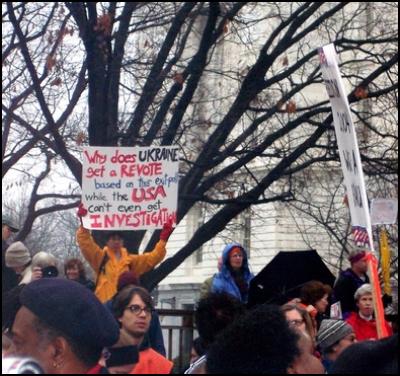
January 6, 2005 Voting Rights advocates assemble at Lafayette Park and march to Capitol Hill outside the Senate office building in support of Sen. Boxer, D, CA challenging the Ohio delegations electoral votes.
We all have an interest in making every election fully transparent and verifiable. We all have an interest in the ability to fully investigate suspected election fraud without being marginalized by the corporate media and secure comfortable national politicians of both parties. We all have a right to vote and have our vote counted accurately.

Simple statement at Ohio post-election protest.
The Voting Rights Act is up for renewal. It is now time for all Americans to wake up and understand that there is only one voting rights movement. It includes Americans of all races. It holds the key to our renewal as a democracy.



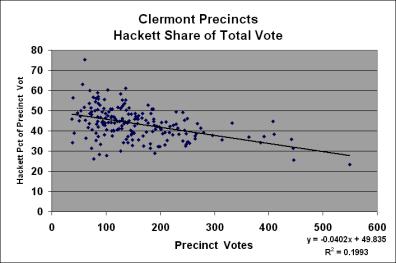
 Binoy Kampmark: Bratty Royal - Prince Harry And Bespoke Security Protection
Binoy Kampmark: Bratty Royal - Prince Harry And Bespoke Security Protection Keith Rankin: Make Deficits Great Again - Maintaining A Pragmatic Balance
Keith Rankin: Make Deficits Great Again - Maintaining A Pragmatic Balance Richard S. Ehrlich: China's Great Wall & Egypt's Pyramids
Richard S. Ehrlich: China's Great Wall & Egypt's Pyramids Gordon Campbell: On Surviving Trump’s Trip To La La Land
Gordon Campbell: On Surviving Trump’s Trip To La La Land Ramzy Baroud: Famine In Gaza - Will We Continue To Watch As Gaza Starves To Death?
Ramzy Baroud: Famine In Gaza - Will We Continue To Watch As Gaza Starves To Death? Peter Dunne: Dunne's Weekly - A Government Backbencher's Lot Not Always A Happy One
Peter Dunne: Dunne's Weekly - A Government Backbencher's Lot Not Always A Happy One